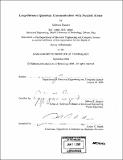| dc.contributor.advisor | Jeffrey H. Shapiro. | en_US |
| dc.contributor.author | Razavi, Mohsen | en_US |
| dc.contributor.other | Massachusetts Institute of Technology. Dept. of Electrical Engineering and Computer Science. | en_US |
| dc.date.accessioned | 2008-02-12T16:47:41Z | |
| dc.date.available | 2008-02-12T16:47:41Z | |
| dc.date.copyright | 2006 | en_US |
| dc.date.issued | 2006 | en_US |
| dc.identifier.uri | http://dspace.mit.edu/handle/1721.1/38313 | en_US |
| dc.identifier.uri | http://hdl.handle.net/1721.1/38313 | |
| dc.description | Thesis (Ph. D.)--Massachusetts Institute of Technology, Dept. of Electrical Engineering and Computer Science, 2006. | en_US |
| dc.description | Includes bibliographical references (p. 132-138). | en_US |
| dc.description.abstract | In this thesis, we develop quantitative performance analyses for a variety of quantum communication/computation systems that have the common feature of employing neutral atoms for storage/processing and photons for qubit transmission. For most of these systems, there is a lack of a precise performance analysis to enable a comparison between different scenarios from a top-level system standpoint. One main goal of this thesis is to fill that gap, thus providing quantum system designers with realistic estimates of system performance that can guide and inform the design process. For many applications in quantum communication and distributed quantum processing, we need to share, in advance, an entangled state between two parties. Thus, entanglement distribution is at the core of long-distance quantum communication systems. It not only includes generation and transmission of entangled states, but it also requires storing them for further processing purposes. Whereas the photons are the prime candidate for the former task, they are not appropriate for long-time storage and processing. Metastable levels in some alkali atoms, e.g., rubidium, are attractive venues for quantum storage. In this thesis, we study several basic quantum memory modules-all based on single trapped atoms in high-finesse optical cavities-and analytically evaluate how efficiently they can be loaded with (entangled) quantum states. | en_US |
| dc.description.abstract | (cont.) We propose a non-adiabatic mechanism for driving off-resonant Raman transitions that can be used in loading trapped-atom quantum memories. Our method is more flexible than its adiabatic counterpart in that it allows use of larger cavities and a larger class of driving sources. We also describe two proposed implementations for long-distance quantum communication-one that uses trapped atoms as quantum memories and another that employs atomic ensembles for quantum storage. We provide, for the first time, a detailed quantitative performance analysis of the latter system, which enables us to compare these two systems in terms of the fidelity and the throughput that they achieve for entanglement distribution, repeater operation, and quantum teleportation. Finally, we study quantum computing systems that use the cross-Kerr nonlinearity between single-photon qubits and a coherent mode of light. The coherent beam serves a mediating role in coupling two weak single-photon beams. We analytically study this structure using a continuous-time formalism for the cross-Kerr effect in optical fibers. Our results establish stringent conditions that must be fulfilled for the system's proper operation. | en_US |
| dc.description.statementofresponsibility | by Mohsen Razavi. | en_US |
| dc.format.extent | 138 p. | en_US |
| dc.language.iso | eng | en_US |
| dc.publisher | Massachusetts Institute of Technology | en_US |
| dc.rights | M.I.T. theses are protected by copyright. They may be viewed from this source for any purpose, but reproduction or distribution in any format is prohibited without written permission. See provided URL for inquiries about permission. | en_US |
| dc.rights.uri | http://dspace.mit.edu/handle/1721.1/38313 | en_US |
| dc.rights.uri | http://dspace.mit.edu/handle/1721.1/7582 | |
| dc.subject | Electrical Engineering and Computer Science. | en_US |
| dc.title | Long-distance quantum communication with neutral atoms | en_US |
| dc.type | Thesis | en_US |
| dc.description.degree | Ph.D. | en_US |
| dc.contributor.department | Massachusetts Institute of Technology. Department of Electrical Engineering and Computer Science | |
| dc.identifier.oclc | 154036944 | en_US |
